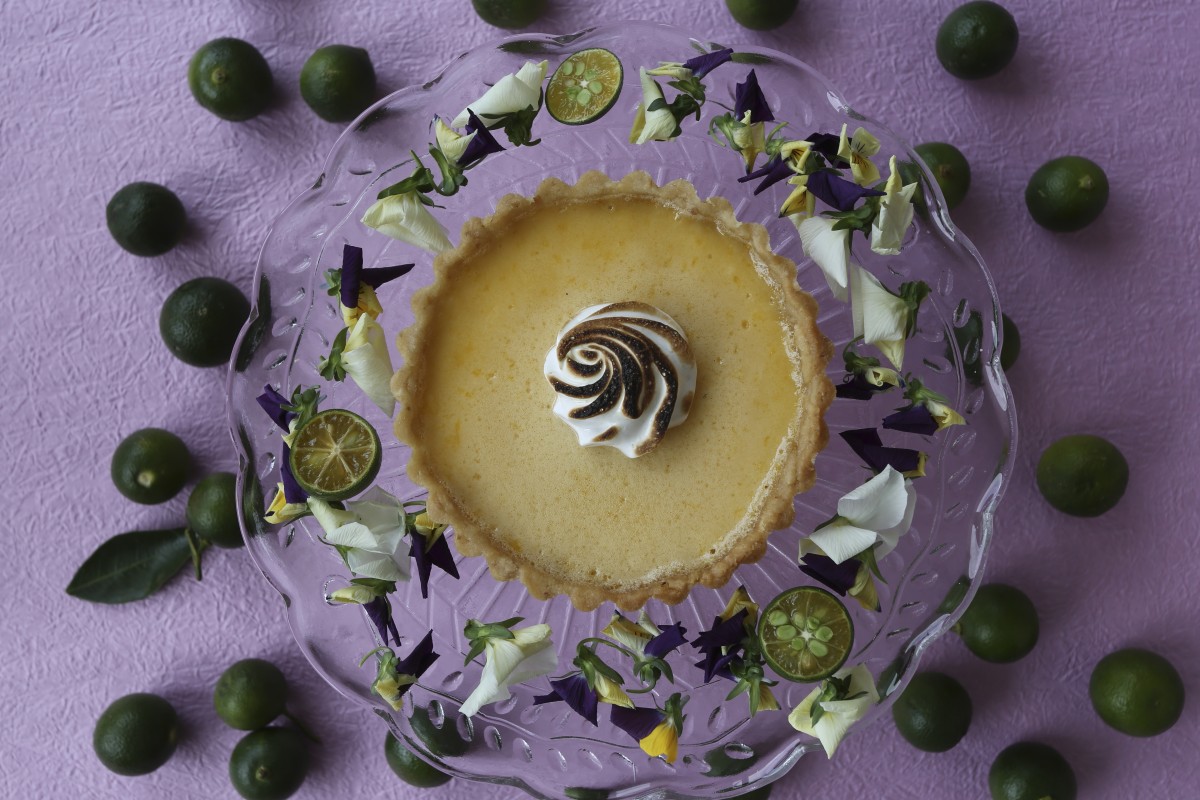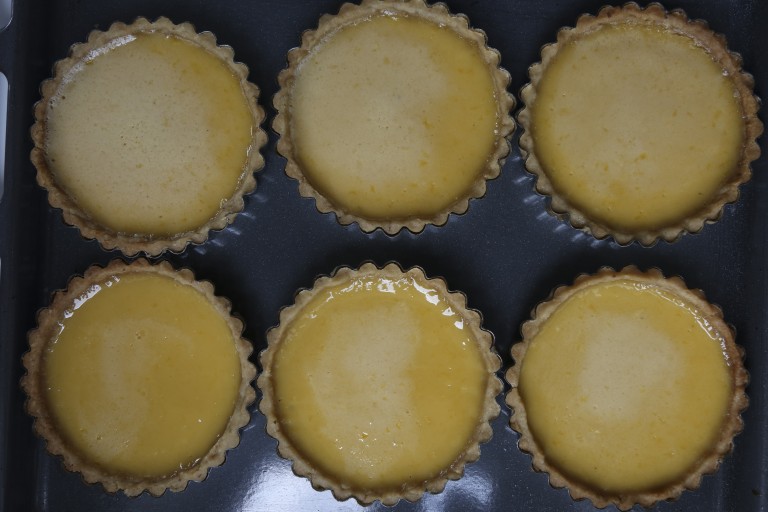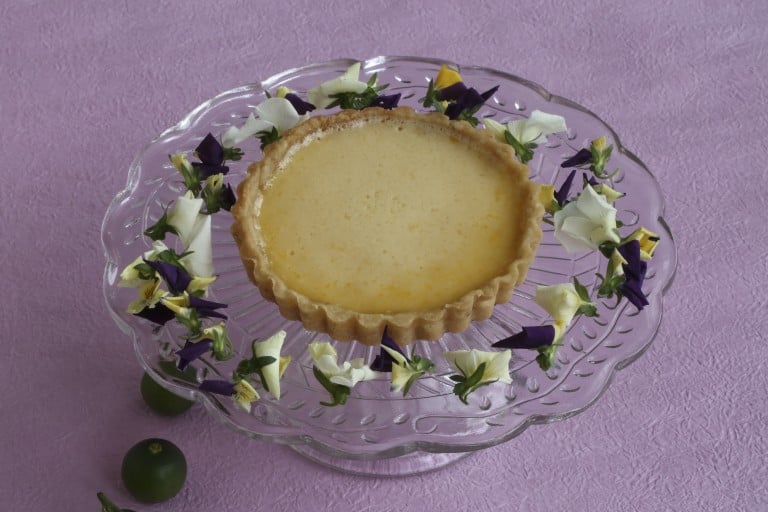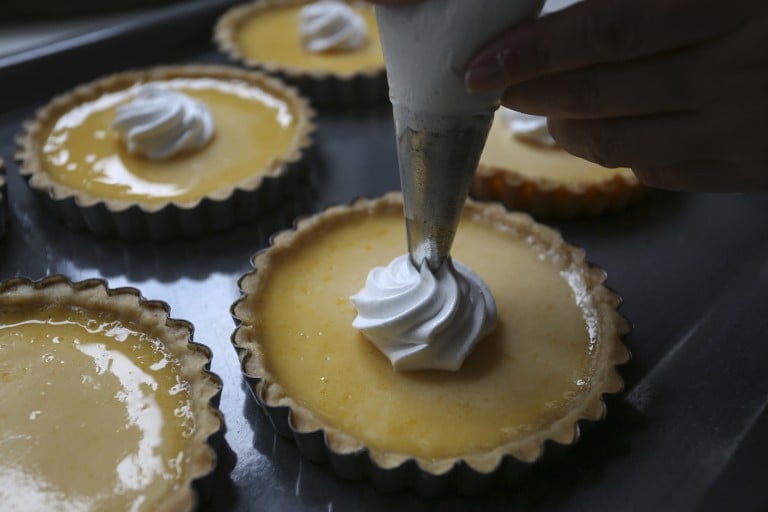
A citrus fruit from the Philippines, calamansi - also called calamondin - is tiny, about 2cm in diameter, but it is intense and tart, with a distinctive flavour. The fruit is usually harvested when the rind is still green, but inside the flesh is bright orange. It makes a fantastic drink - stir it into tonic water, and add a shot or two of rum if you want an alcoholic drink.
This fruit is too small to juice with a standard citrus juicer. The easiest way to juice calamansi is to cut each one in half and squeeze by hand, then strain the juice through a sieve, pressing the pulp and seeds to extract every last drop. You will need at least 30 calamansi to get enough juice for these tarts (don't worry - you can use store-bought fresh calamansi juice). Adding crème fraîche to the filling balances the acidity of the fruit, making it less sharp.
Use individual-serving shallow pans or rings for these tarts. Pans/rings that are 11cm (4⅓ in) in diameter and 2cm (⅞ in) deep will give five generously-sized tarts. For more modest appetites, use pans/rings that are 8cm (3⅛ in) or 9cm (3½ in) in diameter and 2cm deep, which make six or seven tartlets, respectively.
The tart shells can be baked in advance. The filling shouldn’t be baked more than a couple of hours before serving, or it will make the shells soggy. Add and torch the meringue at the last moment.
Preheat the oven to 180°C (350°F). Put the macadamias in a pan and bake them for about 10 minutes, or until lightly toasted. Cool to room temperature.
Put the macadamias with the icing sugar and salt in the bowl of a food processor. Process until the nuts are finely ground. Add the flour and process to combine thoroughly.
Cut the butter into 1cm (7/16 in) cubes and add them to the nut-sugar-flour mixture. Process until the butter is about the size of peas.
Transfer the mixture to a large bowl. Whisk the eggs with the vanilla extract and drizzle this over the dry ingredients. Mix with your fingertips to form a rough dough. Very lightly knead the dough so it’s cohesive, with no dry spots. Divide the dough into three even portions and shape them into discs, then wrap each one in cling-film. Refrigerate for at least two hours.
On a lightly floured work surface, roll the dough to 2mm (less than ⅛ in) thickness. Cut the dough to fit your chosen tart pans or rings. Drape the dough without stretching it so it fits into the contours of the pan/ring, then trim it so it’s flush with the edge. Place the pans/rings on a parchment paper-lined baking pan and refrigerate for at least 30 minutes while preheating the oven to 200°C (390°F). (You won’t need all of the dough for this recipe; it keeps in the fridge for about two weeks, or frozen for longer storage, and is good for other sweet tarts.)
While the dough is chilling, make the calamansi filling. Whisk the eggs with the yolk. Add the salt and sugar and immediately whisk until the mixture is slightly frothy. Whisk in the crème fraîche until fully incorporated, then whisk in the calamansi juice.
Use the tines of a fork to press holes at 1cm (7/16 in) intervals over the bottoms of the chilled tart shells. Press squares of aluminium foil into the shells, fitting the foil into the contours.
Bake the shells at 200°C (390°F) degrees for five minutes, then turn the heat to 180°C (350°F) and bake for about five more minutes, or until the edges of the crust are pale golden and firm. Remove the foil and bake the shells for a few more minutes, or until their surface is matte and the edges are medium-brown. Reduce the oven temperature to 160°C (320°F).

Put the rack holding the tray of tart shells on the lowest shelf of the oven. Pull out the rack slightly from the oven and carefully pour or ladle the calamansi filling into the baked tart shells, filling them almost to the top of the crust. (If you pour the filling into the shells while they are sitting on a kitchen surface, then try to move the tray into the oven, the filling will almost certainly slosh out.) Bake the tarts at 160°C (320°F) for about 15 minutes, or until the filling is set – it will be slightly wobbly at the centre. Take the tarts from the oven and cool to room temperature.

Just before serving dessert, carefully remove the tarts from the pans/rings and place them on individual plates.
Weigh the egg white, then weigh out an equal amount of icing sugar. Sift the icing sugar. Use an electric mixer to whip the egg white with the salt until frothy. Add one quarter of the sugar and whip to combine. Whip in the remaining sugar in three more additions, then continue to whip until the mixture forms a meringue with medium-stiff peaks.

Transfer the meringue to a piping bag fitted with a star tip. Pipe a rosette in the centre of each tart. Use a propane (or butane) torch to brown the meringue. Serve immediately.